
|

|

|

|

|
|
This two-hour program is divided into 12 chapters.
Choose any chapter below and select QuickTime or Windows
Media Player to begin viewing the video. If you
experience difficulty viewing, it may be due to high
demand. We regret this and suggest you try back at
another time.
Technical Help
|
Feedback
|
Program Credits
|
Program Transcript
|

|

|
|
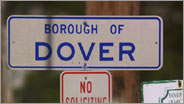
watch chapter 1 in
QuickTime
Windows Media:
hi
|
low
National Science
Education Standards
Grades 5-8
Science in Personal and Social Perspectives
• Science and technology in society
Grades 9-12
Science in Personal and Social Perspectives
• Science and technology in local, national, and
global challenges
|
|
A TOWN DIVIDED
This segment:
-
traces how the issue started in the rural community of
Dover, Pennsylvania, and progressed to become a
federal court test case for science education.
-
defines intelligent design (ID) and explains how the
Dover school board was the first in the nation to
require science teachers to offer ID as an alternative
to evolution.
-
explains why many creationists see evolution as
incompatible with their faith.
-
chronicles the history of legal efforts involving the
teaching of evolution, beginning with the Scopes Trial
in 1925 and culminating in 1987 when the Supreme Court
ruled against teaching creationism.
running time 10:50
|

|

|

|

|

|
|
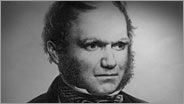
watch chapter 2 in
QuickTime
Windows Media:
hi
|
low
National Science
Education Standards
Grades 5-8
Life Science
• Diversity and adaptation of organisms
History and Nature of Science
• History of science
Grades 9-12
Life Science
• Biological evolution
History and Nature of Science
• Historical perspectives
|
|
WHAT IS EVOLUTION?
This segment:
-
explains how, after studying a number of different
Galapagos finches, Darwin developed his concept of
natural selection, a process by which the forces of
nature select organisms best suited for their
environment.
-
notes that Darwin further reasoned that over time,
natural selection could give rise to new species
through what he termed "descent with modification."
-
illustrates how Darwin pictured the relatedness of all
living things as a great tree of life, with each twig
a different species ultimately descending from a
common ancestor.
-
reports that currently between one-third and one-half
of the U.S. population does not accept evolution.
-
describes how a 16-foot mural depicting the evolution
of humans from an ape-like ancestor was stolen from a
Dover science classroom and burned.
running time 7:04
|

|

|

|

|

|
|
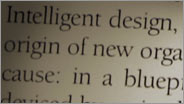
watch chapter 3 in
QuickTime
Windows Media:
hi
|
low
National Science
Education Standards
Grades 5-8
Science in Personal and Social Perspectives
• Science and technology in society
Grades 9-12
Science in Personal and Social Perspectives
• Science and technology in local, national, and
global challenges
|
|
INTRODUCING INTELLIGENT DESIGN
This segment:
-
chronicles how one school board member came to learn
about intelligent design.
-
provides an example from ID literature illustrating
the central tenet of ID that some aspects of life must
be the product of an intelligent designer.
- describes how the ID movement began.
-
recounts how members of the Dover school board drafted
and passed a policy mandating that all students in
ninth-grade biology be read a statement asserting that
Darwin's theory is not a fact and that ID is an
alternative explanation for the origin of life.
running time 8:47
|

|

|

|

|

|
|
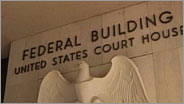
watch chapter 4 in
QuickTime
Windows Media:
hi
|
low
National Science
Education Standards
Grades 5-8
Science in Personal and Social Perspectives
• Science and technology in society
Grades 9-12
Science in Personal and Social Perspectives
• Science and technology in local, national, and
global challenges
|
|
THE TRIAL BEGINS
This segment:
-
reports that 11 parents of Dover students filed a
federal lawsuit on December 14, 2004, alleging that
the Dover school board was violating the parents'
constitutional rights by introducing religion into
science class.
-
shows the school's assistant superintendent reading
the board's mandated statement to students after Dover
science teachers refused to do so.
-
presents opening statements from lawyers in courtroom
recreations based on trial transcripts.
-
points out that to win, the plaintiffs' lawyers would
need to show that the Dover school board statement
promoted religion or that board members had religious
motivations.
-
reports that both sides also asked the judge to rule
on whether ID was science.
running time 9:32
|

|

|

|

|

|
|
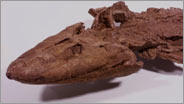
watch chapter 5 in
QuickTime
Windows Media:
hi
|
low
National Science
Education Standards
Grades 5-8
Life Science
• Diversity and adaptation of organisms
History and Nature of Science
• History of science
Grades 9-12
Life Science
• Biological evolution
History and Nature of Science
• Historical perspectives
|
|
THE FOSSIL RECORD
This segment:
-
recreates biologist Ken Miller's courtroom testimony
that defines evolution and reviews Darwin's
contribution to the theory.
-
illustrates Darwin's tree of life showing the
connection, by evolution, of all forms of life on
Earth.
-
illustrates how ID depicts a history of life in which
organisms appear abruptly, are unrelated, and are
linked only by their designer.
-
reports on the discovery of a transitional form
between primitive fish and terrestrial amphibians, and
reviews the characteristics of both species found in
the fossil.
-
reviews some of the transitional fossils presented as
evidence of evolution during the trial.
running time 8:36
|

|

|

|

|

|
|
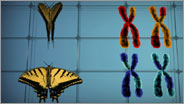
watch chapter 6 in
QuickTime
Windows Media:
hi
|
low
National Science
Education Standards
Grades 5-8
Life Science
• Reproduction and heredity
History and Nature of Science
• Nature of science
Grades 9-12
Life Science
• The molecular basis for heredity
History and Nature of Science
• Nature of scientific knowledge
|
|
A VERY SUCCESSFUL THEORY
This segment:
-
recreates paleontologist's Kevin Padian's courtroom
testimony that defines what the term
theory means in science and Miller's testimony
as to why no theory is regarded as absolute truth.
-
reports on how the field of genetics has revealed the
biological mechanisms that give rise to new traits in
a species.
-
illustrates how DNA can mutate during reproduction to
produce a benign, harmful, or occasionally beneficial
new trait in a species.
-
recreates Miller's testimony detailing evidence for
chromosome fusion in the human genome that would
explain why humans have one pair fewer chromosomes
than the other great apes.
running time 9:26
|

|

|

|

|

|
|
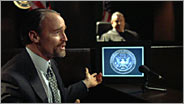
watch chapter 7 in
QuickTime
Windows Media:
hi
|
low
National Science
Education Standards
Grades 5-8
History and Nature of Science
• Nature of science
Grades 9-12
History and Nature of Science
• Nature of scientific knowledge
|
|
THE NATURE OF SCIENCE
This segment:
-
recreates Miller's testimony pointing out that
supernatural causes cannot be tested scientifically.
-
presents an interview with Eugenie Scott, executive
director of the National Center for Science Education,
who says ID is a negative argument that states that
because evolution does not work, an intelligent
designer is responsible for life.
-
recounts the struggles Dover science teachers and
plaintiffs faced for their stance against ID.
-
reports that defense lawyers aimed to show that there
are credible scientists who believe that the empirical
data is supportive of ID.
running time 8:24
|

|

|

|

|

|
|
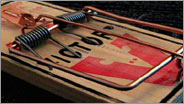
watch chapter 8 in
QuickTime
Windows Media:
hi
|
low
National Science
Education Standards
Grades 5-8
History and Nature of Science
• Nature of science
Grades 9-12
History and Nature of Science
• Nature of scientific knowledge
|
|
EXAMINING INTELLIGENT DESIGN
This segment:
-
recreates biochemist Michael Behe's testimony defining
intelligent design and explaining what is meant by
design in this context.
-
reenacts Behe's testimony in which he provides an
example of irreducible complexity—the bacterial
flagellum, a system that provides propulsion for some
bacteria.
-
shows a structure similar to the flagellum, but less
complex, that functions in bacteria as an apparatus
for transmitting disease.
-
recreates Miller's testimony that demonstrates how a
mousetrap can be modified to work as a tie clip.
running time 9:11
|

|

|

|

|

|
|
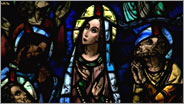
watch chapter 9 in
QuickTime
Windows Media:
hi
|
low
National Science
Education Standards
Grades 5-8
History and Nature of Science
• Nature of science
Grades 9-12
History and Nature of Science
• Nature of scientific knowledge
|
|
FAITH AND REASON
This segment:
-
recreates Behe's testimony claiming that natural
selection fails to account for the immune system and
that there is no scientific literature showing how the
immune system evolved.
-
shows the prosecuting lawyer presenting a large stack
of books and journal articles containing explanations
for how the immune system evolved.
-
recreates microbiologist Scott Minnich's testimony
explaining Behe's assertion that ID could be tested if
a scientist subjected a bacterial species without a
flagellum to a selective pressure such as motility and
grow it for 10,000 generations to see whether it
evolved a flagellum or any other complex system.
-
reports on how the trial affected some of the Dover
residents.
-
presents differing views about evolution's
compatibility with religion.
running time 7:25
|

|

|

|

|

|
|
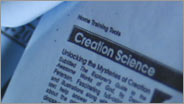
watch chapter 10 in
QuickTime
Windows Media:
hi
|
low
National Science
Education Standards
Grades 5-8
Science in Personal and Social Perspectives
• Science and technology in society
Grades 9-12
Science in Personal and Social Perspectives
• Science and technology in local, national, and
global challenges
|
|
SEPARATION OF CHURCH AND STATE
This segment:
-
notes that to prevail, the prosecution needed to prove
that the school board acted for the purpose of
promoting religion or that its policy had the effect
of promoting religion.
-
recounts how the prosecution found evidence showing
that the text referred to as a resource for ID,
Of Pandas and People, had originally been a
creationist text.
-
describes evidence indicating that one of the leaders
of the ID movement was aware that ID did not yet have
a general theory of biological design.
running time 9:49
|

|

|

|

|

|
|
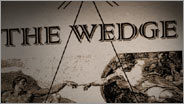
watch chapter 11 in
QuickTime
Windows Media:
hi
|
low
National Science
Education Standards
Grades 5-8
Science in Personal and Social Perspectives
• Science and technology in society
Grades 9-12
Science in Personal and Social Perspectives
• Science and technology in local, national, and
global challenges
|
|
A CULTURE CONFLICT
This segment:
-
notes that the prosecution introduced The Wedge
document, which spells out the ID movement's goals.
-
shows a news video clip in which a school board member
uses the word creationism to describe what
should be taught alongside evolution.
-
recounts that testimony revealed that two school board
members knew—contrary to sworn depositions
stating otherwise—who donated copies of
Of Pandas and People to the school.
running time 8:52
|

|

|

|

|

|
|
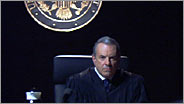
watch chapter 12 in
QuickTime
Windows Media:
hi
|
low
National Science
Education Standards
Grades 5-8
Science in Personal and Social Perspectives
• Science and technology in society
Grades 9-12
Science in Personal and Social Perspectives
• Science and technology in local, national, and
global challenges
|
|
CLOSING ARGUMENTS
This segment:
- presents closing arguments.
-
reports how anti-ID candidates were elected for eight
of nine open Dover school board seats.
-
relates the judge's decision finding both that members
of the school board had religious motivations for
introducing intelligent design into the classroom and
that ID was not a scientific theory.
- provides reactions to the trial.
running time 10:38
|

|

|

|